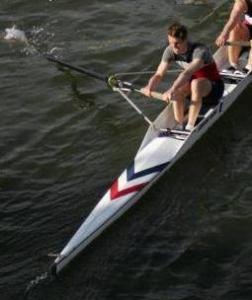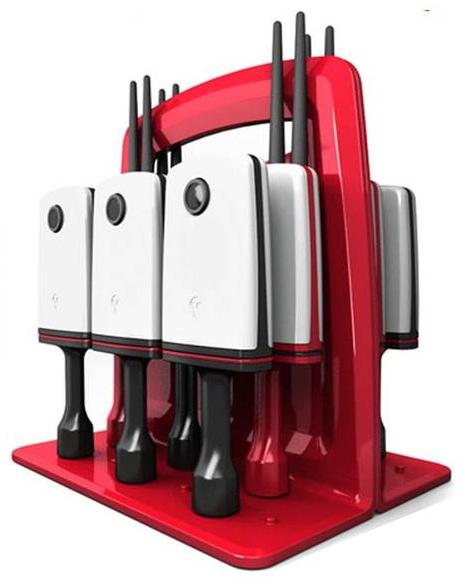I was recently asked to write an article for a new rowing magazine* (Row360 – Row-360.com). The subject of the article was a new coaching aid developed in Australia called Sibi http://yepp.com.au/sibi. At its heart, Sibi is an array of rigger mounted high speed (100 frames / second) video cameras which monitor rowers and their blades during an outing. The hardware is backed up by some very clever software which allows coaches capture, edit and manage the images they need from this array without spending hours on a PC. It tied in very well with my last blog post on the use of smartphones in coaching (Regattas and telephones – are you making best use of them?) although mainly to show how much more we will be able to do with purpose-built video systems rather than general purpose smartphones.
Here’s the full version of the article:
Eyes in the Boat – An Australian Innovation
If there is one technology which has enhanced the coach’s life over the last few years it is digital photography. Whether as video or stills, digital photography has allowed coaches to hold up a mirror to their crews and say “THAT’S what I’m talking about”. From smartphones to Go-Pro cameras to professional video equipment, there’s a price point for every club and every crew.
This year, an Australian company called YePP has taken the next logical step and is marketing a product designed specifically for rowing (called the sibisystem – sibi is short for “see it believe it” yepp.com.au/sibi ) which allows coaches to capture each individual crew member, simultaneously, at 100 frames/sec, during a session, from multiple, dual-lens cameras mounted on the boat. Given the sheer amount of video ‘footage’ their system can create, they have wisely added comprehensive video editing and analysis software as part of their product. So now, in addition to capturing the coach’s eye view from the bank or launch, coaches can record much more detailed close-up, stroke-by-stroke video of each rower’s performance.
Controlled via an  intuitive iPhone app, training requirements are minimal and crucially a recording can be triggered after an event occurs (catching a crab for example) allowing the coach to collect video from before, during and after the event from all cameras simultaneously with a single ‘trigger’.
intuitive iPhone app, training requirements are minimal and crucially a recording can be triggered after an event occurs (catching a crab for example) allowing the coach to collect video from before, during and after the event from all cameras simultaneously with a single ‘trigger’.
When I first heard about it, I must admit I thought this was probably an “elite squad only” product, but in fact schools have been among the first users – and potentially in any rowing club which doesn’t have enough coaches to go round or where coaches also have to cox their crews (my least favourite coaching option) this product could be a real game-changer. While the coach can continue to provide real-time feedback, YePP’s sibisystem provides indisputable objective evidence as to how the rowers and blades were working during a session – both in terms of individual technique and their timing with the rest of the crew.
The user’s view
For those of you who are interested in the technical details of the cameras there’s a webpage here: yepp.com.au/sibi/camera. However, I was more interested in discovering what the coaches and rowers who had used the system thought of it. I was able to speak to two users on YePP’s Early Adopter Programme from Melbourne Girls Grammar, namely Christian Neeson, Director of Physical Performance and Health, and Lachlan Beckett, Head of Rowing. Melbourne Girls Grammar have a history of innovation in rowing, having put the first girls crews out on the Yarra River as early as 1905. Not surprisingly therefore, they were among the first to use video recording as a routine part of their coaching repertoire and as early as 2010 were experimenting with GoPro cameras attached to boats, blades and coxes heads. While they got lots of useful footage from the cameras, coaches also discovered the practical limitations of the technology and the hours of time it took to review and edit the material placed real constraints on how often cameras could be used.
Working with YePP allowed them to make a major step forward in their coaching. In Christian Neeson’s opinion “the ease with which we can ‘time-travel’ through the record of an outing makes a real difference and as a bonus we’ve also saved on the costs of having people following the boats with cameras”. With 120 athletes to look after, he now has an archive of individual recordings for much of the squad which can be reviewed with coaches, parents and the athletes themselves.

As Head of Rowing, Lachlan Beckett is responsible for a team of 36 coaches and uses the sibisystem to track the progress of individual coach’s training plans. He also feels it has changed the way they coach. “Traditionally, coaches would spend time during an outing sorting out issues of technique with individual rowers. This would occasionally lead to rowers feeling ‘picked on’ or neglected – which is certainly not what you want in a school environment. YePP has allowed each rower access to an entirely objective record of their own performance, annotated if necessary by both their coach and themselves, which they can own and which can form the basis of a more obviously equitable teaching environment. So they’re happier, more proficient technically as rowers and more competitive as a result.”
SibiSystem – Overview
Unlike general purpose video products, the Sibisystem has been designed for rowers and no-one else. The cameras are not just waterproof, they are designed for simple attachment to racing boats and their two lenses capture synchronised video of both rower and blade. With up to eight synchronised cameras (16 views) per boat coaches can capture up to 200×15 second sequences at 100 frames/second during an outing, triggered from an iPhone app.
The hardware is controlled by an integrated suite of software designed around coaches and rowers. Video archives can be maintained for each individual rower and annotated by both coach and rower. Recordings can be compared to show progress over time. The system is self-contained and needs no additional IT infrastructure other than in Internet link. The current version of the product is based on five years of research and development and additional features are in the product pipeline for future release.
YePP have a team in place to support both the ongoing development of the product and the successful deployment in clubs around the world. With the financial capabilities of most rowing clubs in mind, they have designed a purchase plan based on a small up-front payment followed by an ongoing monthly fee. For this each customer gets 8 dual-lens Cameras, 4 Bridges, 1 Hub, accessories and 98 User licences. The fee includes all upgrades and new releases.
Is it for you?
My guess is that the coaches who will make best use of YePP’s sibisystem are probably (like Melbourne Girls Grammar) already routinely using video and photography as part of their coaching toolkit. They will most appreciate the step up in capability that it provides and their rowers will gain the greatest competitive advantage from it. And to rowing clubs and coaches out there who aren’t using video yet, the message is “look out”, because coaching is changing – and YePP’s sibisystem is setting a new benchmark for the coach/rower relationship.
Full product descriptions and technical details are available on the company website at http://yepp.com.au/ .
*This is a longer version of the article published in the September/October 2014 edition of Row360.



 intuitive iPhone app, training requirements are minimal and crucially a recording can be triggered after an event occurs (catching a crab for example) allowing the coach to collect video from before, during and after the event from all cameras simultaneously with a single ‘trigger’.
intuitive iPhone app, training requirements are minimal and crucially a recording can be triggered after an event occurs (catching a crab for example) allowing the coach to collect video from before, during and after the event from all cameras simultaneously with a single ‘trigger’.